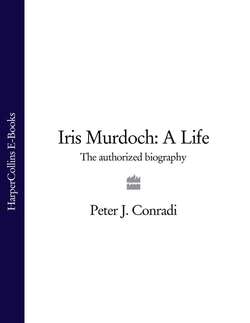Читать книгу Iris Murdoch: A Life: The Authorized Biography - Peter Conradi J. - Страница 23
5
ОглавлениеAfter her arrival at Froebel in 1927, Miriam Allott (née Farris), sat next to Iris.
The prime image: Iris in profile on my right – sitting together on the same bench? Or two desks close together? This strong image is a kind of close-up: head bent forward but not far enough to hide outline of the features – slightly snub nose, slightly retroussé, high cheek bones, high colour there … I can hear the strong Irish brogue, firm clear voice, forceful, authoritative enunciation (possibly countering shyness) … Round her neck a thin cord suspending a money purse which disappeared under the protective tunic – I didn’t wear such a purse but many did.
It was this image which darted into Allott’s head when, thirty years later and a literary critic, she saw an Observer profile on Iris and realised for the first time that the novelist whose works she had begun to teach at university, and to publish on, was her fellow Old Froebelian.34 Miriam’s mother may have been uneasy about Iris, possibly in case she were a bit of a tomboy, possibly because she was Irish. Miriam had two imaginary and genderless friends, known as Chelsea and Battersea, while Iris for her part invented a brother, her references to whom always ‘express[ed] some special feeling for him’. He was a rounded character who developed over time. Miriam Allott wrote to Iris in the 1960s that she wondered ‘whether the character of Toby in The Bell had been inspired by Iris’s brother’.35 Iris’s reply could not have touched on this subject, since Allott was stunned to learn only in 1998 that he never existed.* It is hard to know how much to make of this. The invention of an imaginary or magical friend or sibling is not uncommon among children. It can assuage loneliness by providing fantasy company, but in another sense increase it because of the complications involved in inviting friends home, leading to possible discovery. Living within a fictional world can replace the satisfactions of real friendship. It can also augment the intimacy of the family unit.
Iris herself said that she began writing stories at nine in order to provide herself with imaginary siblings. So writing was an extension of inventing companions. She ‘loved words, sentences, paragraphs'; learning Latin at Froebel made a deep impression also.36 All this suggests some qualification of the purely ‘idyllic’ picture of her childhood, and a compensatory process that started early. There are few clues. One comes in a 1945 letter in which Iris described her childhood as a time when she sometimes felt ‘weak at the knees’, and, presumably remembering her anxieties as a child, goes on, ‘What a fantastic frightening irrational world one lives in.’37 Writing as a strategy for assuaging anxiety or loneliness is certainly common: witness, for example, Beatrix Potter or Elizabeth Bowen.
